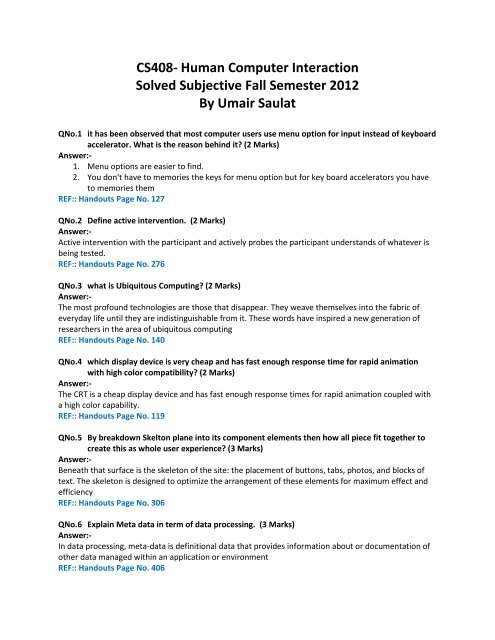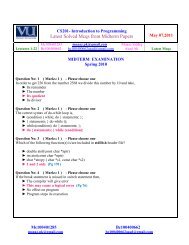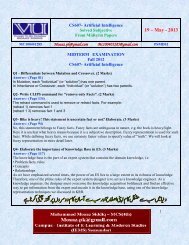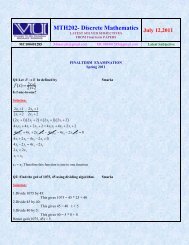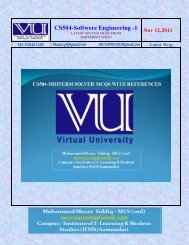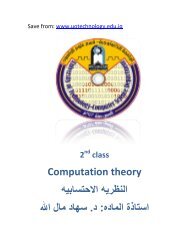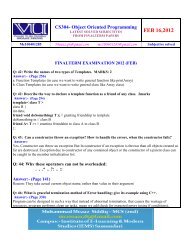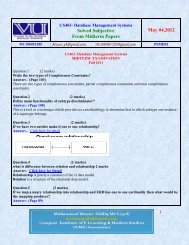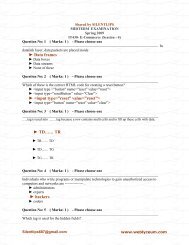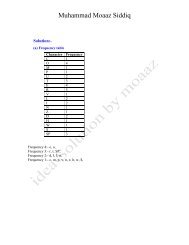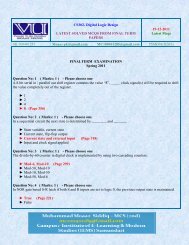CS408- Human Computer Interaction Solved Subjective Fall ... - vuZs
CS408- Human Computer Interaction Solved Subjective Fall ... - vuZs
CS408- Human Computer Interaction Solved Subjective Fall ... - vuZs
You also want an ePaper? Increase the reach of your titles
YUMPU automatically turns print PDFs into web optimized ePapers that Google loves.
<strong>CS408</strong>- <strong>Human</strong> <strong>Computer</strong> <strong>Interaction</strong><br />
<strong>Solved</strong> <strong>Subjective</strong> <strong>Fall</strong> Semester 2012<br />
By Umair Saulat<br />
QNo.1 it has been observed that most computer users use menu option for input instead of keyboard<br />
accelerator. What is the reason behind it (2 Marks)<br />
Answer:-<br />
1. Menu options are easier to find.<br />
2. You don't have to memories the keys for menu option but for key board accelerators you have<br />
to memories them<br />
REF:: Handouts Page No. 127<br />
QNo.2 Define active intervention. (2 Marks)<br />
Answer:-<br />
Active intervention with the participant and actively probes the participant understands of whatever is<br />
being tested.<br />
REF:: Handouts Page No. 276<br />
QNo.3 what is Ubiquitous Computing (2 Marks)<br />
Answer:-<br />
The most profound technologies are those that disappear. They weave themselves into the fabric of<br />
everyday life until they are indistinguishable from it. These words have inspired a new generation of<br />
researchers in the area of ubiquitous computing<br />
REF:: Handouts Page No. 140<br />
QNo.4 which display device is very cheap and has fast enough response time for rapid animation<br />
with high color compatibility (2 Marks)<br />
Answer:-<br />
The CRT is a cheap display device and has fast enough response times for rapid animation coupled with<br />
a high color capability.<br />
REF:: Handouts Page No. 119<br />
QNo.5 By breakdown Skelton plane into its component elements then how all piece fit together to<br />
create this as whole user experience (3 Marks)<br />
Answer:-<br />
Beneath that surface is the skeleton of the site: the placement of buttons, tabs, photos, and blocks of<br />
text. The skeleton is designed to optimize the arrangement of these elements for maximum effect and<br />
efficiency<br />
REF:: Handouts Page No. 306<br />
QNo.6 Explain Meta data in term of data processing. (3 Marks)<br />
Answer:-<br />
In data processing, meta-data is definitional data that provides information about or documentation of<br />
other data managed within an application or environment<br />
REF:: Handouts Page No. 406
QNo.7 suppose you are a system analyst, with your work experience, briefly describe when it is<br />
useful to observe in contrast to observation process (3 Marks)<br />
Answer:-<br />
Being a system analyst, Early in design, observation helps designers understand users' needs. Other<br />
types of observation are done later to examine whether the developing prototype meets users' needs.<br />
REF:: Handouts Page No. 361<br />
QNo.8 Describe any five usability goals of Internet Explorer. (5 Marks)<br />
Answer:-<br />
Usability is broken down into the following goals:<br />
1. Effective to use (effectiveness)<br />
2. Efficient to use (efficiency)<br />
3. Safe to use(safety)<br />
4. Have good utility (utility)<br />
5. Easy to learn (learnability)<br />
1. Effectiveness<br />
It is a very general goal and refers to how good a system at doing what it is suppose to do.<br />
2. Efficiency<br />
It refers to the way a system supports users in carrying out their tasks.<br />
3. Safety<br />
It involves protecting the users from dangerous conditions and undesirable situations. In<br />
relation to the first ergonomics aspect, it refers to the external conditions where people<br />
work.<br />
4. Utility<br />
It refers to the extent to which the system provides the right kind of functionality so that<br />
user can do what they need or want to do<br />
5. Learnability<br />
It refers to how easy a system is to learn to use. It is well known that people do not like<br />
spending a long time learning how to use a system<br />
REF:: Handouts Page No. 31
QNo.9 when observation is useful and how to observe (5 Marks)<br />
Answer:-<br />
Observing is useful at any time during product development. Early in design, observation helps designers<br />
understand users' needs.<br />
How to observe<br />
The same basic data-collection tools are used for laboratory and field studies (i.e., direct observation,<br />
taking notes, collecting video, etc.) but the way in which they are used is different. In the laboratory the<br />
emphasis is on the details of what individuals do, while in the field the context is important and the<br />
focus is on how people interact with each other, the technology, and their environment. Furthermore,<br />
the equipment in the laboratory is usually set up in advance and is relatively static whereas in the field it<br />
usually must be moved around. In this section we discuss how to observe, and then examine the<br />
practicalities and compare data-collection tools.<br />
REF:: Handouts Page No. 361<br />
QNo.10 Difference between Semi-structure interview and focus group interview. (5 Marks)<br />
Answer:-<br />
Semi-Structure Interview<br />
Focus Group Interview<br />
Semi-structured, interviews combine <br />
features of structured and<br />
unstructured inter views and use both<br />
closed and open questions.<br />
social sciences research.<br />
Use of pre-determined questions <br />
<br />
<br />
REF:: Handouts Page No. 373<br />
provides uniformity<br />
Requires some level of training or<br />
practice in order to prevent<br />
interviewer suggesting answers<br />
It also allows respondents to discuss<br />
and raise issues that you may not have<br />
considered<br />
One form of group interview is the<br />
focus group that is frequently used in<br />
marketing, political campaigning, and<br />
Normally three to 10 people are<br />
involved.<br />
Focus groups are also attractive<br />
because they are low-cost, provide<br />
quick results, and can easily be scaled<br />
to gather more data.<br />
A preset agenda is developed to guide<br />
the discussion<br />
QNo.10 Differentiate between Visual Art and Visual Design<br />
Answer:-<br />
Visual Art<br />
Visual art is art such as paintings,<br />
photographs, sculptures,<br />
The term visual art separates those<br />
kinds of art from music, dance, and<br />
drama.<br />
It is two-dimensional. Visual arts are<br />
things like paintings, drawings, visual<br />
designs, photography, and computer<br />
art.<br />
There is no "designing" for a purpose;<br />
<br />
<br />
<br />
Visual Design<br />
Visual design is the way a piece of<br />
artwork, a room, yard, video game,<br />
photo or other artistic subject is<br />
composed and appeals to the human<br />
eye<br />
Photoshop designs for each page,<br />
page type, module within an<br />
app/site/software.<br />
Creates or contributes to style guides<br />
detailing how everything looks and
it's just creating something visually how it fits into the larger strategy.<br />
appealing.<br />
QNo.11 which theory claimed Problem solving is both productive and reproductive what are<br />
controlled vocabularies<br />
Answer:-<br />
Gestalt theory<br />
Gestalt psychologists were answering the claim, made by behaviorists, that problem solving is a matter<br />
of reproducing known responses or trial and error. This explanation was considered by the Gestalt<br />
school to be insufficient to account for human problem solving behavior.<br />
REF:: Handouts Page No. 91<br />
QNo.12 how active intervention technique performed<br />
Answer:-<br />
Active intervention is particularly useful early in design. It is an excellent technique to use with<br />
prototypes, because it provides a wealth of diagnostic information. It is not the technique to use;<br />
however, if your primary concern is to measure time to complete tasks or to find out how often users<br />
will call the help desk. To do a useful active intervention test, you have to define your goals and<br />
concerns, plan the questions you will use as probes, and be careful not to bias participants by asking<br />
leading questions.<br />
REF:: Handouts Page No. 276<br />
QNo.13 Application software implemented in file system model<br />
Answer:-<br />
Software implemented in the file system model: Our software is already designed and built that way,<br />
and users are used to it neither of these arguments is valid. The first one is irrelevant because new<br />
programs written with a unified file model can freely coexist with the older implementation model<br />
applications. The underlying file system doesn't change at all. In much the same way that toolbars<br />
quickly invaded the interfaces of most applications in the last few years, the unified file model could also<br />
be implemented with similar success and user acclaim.<br />
The second argument is more insidious, because its proponents place the user community in front of<br />
them like a shield. What's more, if you ask users themselves, they will reject the new solution because<br />
they abhor change, particularly when that change affects something they have already worked hard to<br />
master — like the file system. However, users are not always the best predictors of design successes,<br />
especially when the designs are different from anything they've already experienced,<br />
REF:: Handouts Page No. 330<br />
QNo.14 explain metadata in term of data processing<br />
Answer:-<br />
In data processing, meta-data is definitional data that provides information about or documentation of<br />
other data managed within an application or environment.<br />
For example:-<br />
Meta-data would document data about data elements or attributes (name, size, data type, etc) and data<br />
about records or data structures (length, fields, columns, etc) and data about data (where it is located,<br />
how it is associated, ownership, etc.).<br />
REF:: Handouts Page No. 406
QNo.15 Point out the problem with Excise task<br />
Answer:-<br />
The problem with excise tasks is that the effort we expend in doing them doesn’t go directly towards<br />
accomplishing our goals. Where we can eliminate the need for excise tasks, we make the user more<br />
effective and productive and improve the usability of the software.<br />
REF:: Handouts Page No. 246<br />
QNo.16 Define controlled Vocabularies<br />
Answer:-<br />
Vocabulary control comes in many shapes and sizes. At its most vague, a controlled vocabulary is any<br />
defined subset of natural language. At its simplest, a controlled vocabulary is a list of equivalent terms in<br />
the form of a synonym ring, or a list of preferred terms in the form of an authority file.<br />
REF:: Handouts Page No. 407<br />
QNo.17 Write principles to prevent user privacy<br />
Answer:-<br />
Most previous evaluations in human-computer interaction, these studies can be done without users<br />
knowing that they are being studied. This raises ethical concerns, chief among which are issues of<br />
privacy, confidentiality, informed consent, and appropriation of others’ personal stories (Sharf, 1999).<br />
People often say things online that they would not say face to face.<br />
REF:: Handouts Page No. 268<br />
QNo.18 what is Scope Plane in context of elements of user experience<br />
Answer:-<br />
On the software side, the strategy is translated into scope through the creation of functional<br />
specifications: a detailed description of the "feature set" of the product. On the information space side,<br />
scope takes the form of content requirements: a description of the various content elements that will be<br />
required. Now we can map that whole confusing array of terms into the model. By breaking each plane<br />
down into its component elements, we'll be able to take a closer look at how all the pieces fit together<br />
to create the whole user experience.<br />
REF:: Handouts Page No. 308<br />
QNo.19 by breaking down Skeleton plane into its component elements then how all the pieces fit<br />
together to create this as a whole user experience<br />
Answer:-<br />
The skeleton plane breaks down into three components.<br />
1. On both sides, we must address information design:<br />
The presentation of information in a way that facilitates understanding.<br />
2. For software products:<br />
The skeleton also includes interface design, or arranging interface elements to enable users to<br />
interact with the functionality of the system.<br />
3. The interface for an information space is its navigation design:<br />
The set of screen elements that allow the user to move through the information architecture<br />
REF:: Handouts Page No. 308
QNo.20 what "function" will create a copy of the original document in MS Word<br />
Answer:-<br />
The word snapshot makes it clear that the copy is identical to the original, while also making it clear that<br />
the copy is not tied to the original in any way. That is, subsequent changes to the original will have no<br />
effect on the copy.<br />
REF:: Handouts Page No. 326<br />
QNo.21 Define Strategy and Scope planes<br />
Answer:-<br />
Strategy Planes<br />
The scope is fundamentally determined by the strategy of the site. This strategy incorporates not only<br />
what the people running the site want to get out of it but what the users want to get out of the site as<br />
well. In the case of our bookstore example, some of the strategic objectives are pretty obvious: Users<br />
want to buy books, and we want to sell them. Other objectives might not be so easy to articulate.<br />
Scope planes<br />
On the software side, the strategy is translated into scope through the creation of functional<br />
specifications: a detailed description of the "feature set" of the product. On the information space side,<br />
scope takes the form of content requirements: a description of the various content elements that will be<br />
required.<br />
REF:: Handouts Page No. 307, 308<br />
QNo.22 Usability tests<br />
Answer:-<br />
In most usability tests, you have one participant at a time working with the product. You usually leave<br />
that person alone and observe from a corner of the room or from behind a one-way mirror.<br />
REF:: Handouts Page No. 275<br />
QNo.23 Identify the main components that make up a global navigation system in context of a web.<br />
Answer:-<br />
Web designers use the term penitent navigation (or global navigation) to describe the set of navigation<br />
elements that appear on every page of a site, Persistent navigation should include the five elements you<br />
most need to have on hand at all times.<br />
1. The Home page.<br />
2. Forms.<br />
3. Site ID<br />
4. The Sections<br />
5. The Utilities<br />
REF:: Handouts Page No. 287,288<br />
QNo.24 You are a software engineer and design different applications that are usable for users<br />
without modifications. How do you define accessibility with respect to emerging<br />
paradigm (5)<br />
Answer:-<br />
Accessibility is a general term used to describe the degree to which a system is usable by as many<br />
people as possible without modification. It is not to be confused with usability which is used to describe<br />
how easily a thing can be used by any type of user. One meaning of accessibility specifically focuses on
people with disabilities and their use of assistive devices such as screen-reading web browsers or<br />
wheelchairs.<br />
REF:: Handouts Page No. 408<br />
QNo.25 Suppose you are an HCI specialist, what do you think that evaluation of design or product is<br />
beneficial Justify your point of view. (5 marks)<br />
Answer:-<br />
HCI specialists test design ideas on real users and use formal evaluation techniques to replace intuition<br />
in guiding design. This constant reality check improves the final product.<br />
o most effectively develop programs and products designed to meet customer needs, all operations are<br />
strongly science based. For example, our research and development teams emphasize improving rearing<br />
methodologies for current and new products, designing consistently significant quality control<br />
evaluations, improving natural enemy delivery methodologies and developing technologies for field<br />
population monitoring. Our science-based efforts are the best means to achieve and maintain the<br />
highest standards of program and product quality.<br />
1. Problems are fixed before the product is shipped, not after.<br />
2. The team can concentrate on real problems, not imaginary ones.<br />
3. Engineers code instead of debating.<br />
4. Time to market is sharply reduced.<br />
5. Finally, upon first release, your sales department has a rock-solid design it can sell without<br />
having to pepper their pitches with how it will all actually work in release 1.1 or 2.0.<br />
REF:: Handouts Page No. 21,257<br />
QNo.26 Match the following regarding Goal-Directed Design (5marks)<br />
A<br />
B<br />
Research<br />
Users and use Context<br />
Modeling<br />
Definition of user, business& technical needs<br />
Requirements Definition of design structure & flow<br />
Framework Of behavior, form & content<br />
Refinement User and the Domain<br />
Answer:-<br />
A<br />
B<br />
Research<br />
User and the Domain<br />
Modeling<br />
Users and use Context<br />
Requirements Definition of user, business& technical needs<br />
Framework Definition of design structure & flow<br />
Refinement Of behavior, form & content<br />
REF:: Handouts Page No. 155<br />
QNo.27 Suppose you are creating an account on yahoo, fill all the required information but forget to<br />
retype password. As you click on submit button a warning is message appears “This<br />
information is required” on retype password field. Yahoo suggests that your registration will<br />
not be submitted until you retype password. Explain this specific characteristic of considerate<br />
software.(3 marks)<br />
Answer:-
It ensures there are no mistakes while typing the password because retyping matches and makes sure<br />
you do not make a mistake. You can type an error password once but not twice. This is a security check<br />
and it’s good for user.<br />
QNo.28 you are assigned to perform trunk test on website "amazon.com". Write down all the<br />
necessary steps to perform the trunk test.(3 marks)<br />
Answer:-<br />
Imagine that you've been blindfolded and locked in the trunk of a car, then driven around for a while<br />
and dumped on a page somewhere deep in the bowels of a Web site. If the page is well designed, when<br />
your vision clears you should be able to answer these questions without hesitation:<br />
1. What site is this (Site ID) amazon.com<br />
2. • What page am I on (Page name)<br />
3. • What are the major sections of this site (Sections)<br />
4. • What are my options at this level (Local navigation)<br />
5. • Where am I in the scheme of things ("You are here" indicators)<br />
6. • How can I search<br />
REF:: Handouts Page No. 296<br />
QNo.29 I am working on a web site and have designed a home page. The information I added does not<br />
fit into screen size of computer. I do not want to remove any data from this page. Is this any<br />
solution that all data can be shown to user(3 marks)<br />
Answer:-<br />
Tabs can be used to group related data under one heading and then creating different sections. Scroll<br />
bars can be used for data which does not fit on one screen. Different sections can be created with a<br />
heading and some content given on main page with a "Read More" indicator. This will take user to a<br />
new page if user is interested in reading more.<br />
QNo.30 Suppose you are a web developer. While designing web applications you use metadata tags in<br />
your application that make efficient search Briefly explain metadata and its purpose in web<br />
site. (3 marks)<br />
Answer:-<br />
A web site is a collection of interconnected systems with complex dependencies. A single link on a page<br />
can simultaneously be part of the site's structure, organization, labeling, navigation, and searching<br />
systems. It's useful to study these systems independently, but it's also crucial to consider how they<br />
interact. Reductionism will not tell us the whole truth.<br />
REF:: Handouts Page No. 406<br />
QNo.31 Suppose you are an HCI specialist and have to perform the usability testing for those products<br />
that do not even have to involve any hardware or software. Which usability testing techniques<br />
you will use in this case. (2 marks)<br />
Answer:-<br />
Usability testing was the dominant approach in the 1980s (Whiteside et al., 1998), and remains<br />
important, although, as you will see, field studies and heuristic evaluations have grown in prominence.<br />
REF:: Handouts Page No. 259<br />
QNo.32 Which screen display when user launches the program and first loads into the memory(2<br />
marks)<br />
Answer:-
A splash screen is a dialog box displayed when a program first loads into memory. Sometimes it may just<br />
be the about box or Identity box, displayed automatically, but more often publishers create a separate<br />
splash screen that is more engaging and visually exciting<br />
REF:: Handouts Page No. 398<br />
QNo.33 what is the mean by life cycle of module Why they are used in software development.<br />
Answer:-<br />
Understanding what activities are involved in interaction design is the first step to being able to do it,<br />
but it is also important to consider how the activities are related to one another so that the full<br />
development process can be seen. The term lifecycle model is used to represent a model that captures a<br />
set of activities and how they are related.<br />
SDLC stands for Software Development Life Cycle. A Software Development Life Cycle is essentially a<br />
series of steps, or phases, that provide a model for the development and lifecycle management of an<br />
application or piece of software. The methodology within the SDLC process can vary across industries<br />
and organizations, but standards such as ISO/IEC 12207 represent processes that establish a lifecycle for<br />
software, and provide a mode for the development, acquisition, and configuration of software systems<br />
REF:: Handouts Page No. 149<br />
http://www.veracode.com/security/software-development-lifecycle<br />
QNo.34 Explain the concept of Attentive environment<br />
Answer:-<br />
Attentive environments are environments that are user and context aware. One project which explores<br />
these themes is IBM's Blue Eyes research project is chartered to explore and define attentive<br />
environments.<br />
software, and provide a mode for the development, acquisition, and configuration of software systems<br />
REF:: Handouts Page No. 418<br />
QNo.34 Explain the following planes of conceptual framework for development interactive<br />
product<br />
• The structure plane<br />
• The strategy plane<br />
Answer:-<br />
The structure plane<br />
The skeleton is a concrete expression of the more abstract structure of the site. The skeleton might<br />
define the placement of the interface elements on our checkout page; the structure would define how<br />
users got to that page and where they could go when they were finished there. The skeleton might<br />
define the arrangement of navigational items allowing the users to browse categories of books; the<br />
structure would define what those categories actually were.<br />
The strategy plane<br />
The scope is fundamentally determined by the strategy of the site. This strategy incorporates not only<br />
what the people running the site want to get out of it but what the users want to get out of the site as<br />
well. In the case of our bookstore example, some of the strategic objectives are pretty obvious: Users<br />
want to buy books, and we want to sell them. Other objectives might not be so easy to articulate.<br />
REF:: Handouts Page No. 306 ,307
QNo.35 What are good reasons for investing in user testing which are points out by tognazzini<br />
Answer:-<br />
Tognazzini points out that there are five good reasons for investing in user testing:<br />
1. Problems are fixed before the product is shipped, not after.<br />
2. The team can concentrate on real problems, not imaginary ones.<br />
3. Engineers code instead of debating.<br />
4. Time to market is sharply reduced.<br />
5. Finally, upon first release, your sales department has a rock-solid design it can sell without<br />
having to pepper their pitches with how it will all actually work in release 1.1 or 2.0.<br />
REF:: Handouts Page No. 257<br />
QNo.36 How navigation excised justify your answer<br />
Answer:-<br />
The most important thing to realize about navigation is that, in almost all cases, it represents pure<br />
excise, or something close to it. Except in games where the goal is to navigate successfully through a<br />
maze of obstacles, navigating through software does not meet user goals, needs, or desires.<br />
Unnecessary or difficult<br />
REF:: Handouts Page No. 248<br />
QNo.37 Why some time direct observation is not possible<br />
Answer:-<br />
Sometimes direct observation is not possible because it is obtrusive or evaluators cannot be present<br />
over the duration of the study, and so users' activities are tracked indirectly.<br />
REF:: Handouts Page No. 366<br />
QNo.38 Give two examples of “Avoidance” with respect to Attitude-oriented questions. [2<br />
Answer:-<br />
What would you prefer not to do<br />
What do you procrastinate on<br />
REF:: Handouts Page No. 183<br />
QNo.39 Write any two common ways to Improve Navigation [2]<br />
Answer:-<br />
1. One integrated within a web site or intranet to improve navigation and retrieval, shares a<br />
common heritage with the familiar reference text but has a different form and function.<br />
2. Thesaurus is a semantic network of concepts, connecting words to their synonyms, homonyms,<br />
antonyms, broader and narrower terms, and related terms.<br />
REF:: Handouts Page No. 408<br />
QNo.39 List down any four principles that can help make your visual interface as easy and pleasurable<br />
to use as possible.<br />
Answer:-<br />
1. Avoid visual noise and clutter<br />
2. Use contrast, similarity, and layering to distinguish and organize elements<br />
3. Provide visual structure and flow at each level of organization<br />
4. Use cohesive, consistent, and contextually appropriate imagery
5. Integrate style and function comprehensively and purposefully<br />
REF:: Handouts Page No. 345<br />
QNo.40 Explain “Participants Represent Real Users” in context of usability testing.<br />
Answer:-<br />
While there can be wide variations in where and how you conduct a usability test, every usability test<br />
shares these five characteristics:<br />
1. The primary goal is to improve the usability of a product. For each test, you also have more<br />
specific goals and concerns that you articulate when planning the test.<br />
2. The participants represent real users.<br />
3. The participants do real tasks.<br />
4. You observe and record what participants do and say.<br />
5. You analyze the data, diagnose the real problems, and recommend changes to fix those<br />
problems.<br />
REF:: Handouts Page No. 270<br />
QNo.41 When is it useful to observe in context to observation process [3]<br />
Answer:-<br />
Observing is useful at any time during product development. Early in design, observation helps designers<br />
understand users' needs. Other types of observation are done later to examine whether the developing<br />
prototype meets users' needs<br />
REF:: Handouts Page No. 361<br />
QNo.42 Discuss the model problems of multiple undo.<br />
Answer:-<br />
The problems with multiple undo are not due to its behavior as much as they are due to its manifest<br />
model. Most undo facilities are constructed in an unrelentingly function-centric manner. They<br />
remember what the user does function-by-function and separate the user's actions by individual<br />
function. In the time-honored way of creating manifest models that follow implementation models,<br />
undo systems tend to model code and data structures instead of user goals. Each click of the Undo<br />
button reverses precisely one function-sized bite of behavior. Reversing on a function-by-function basis<br />
is a very appropriate mental model for solving most simple problems caused by the user making an<br />
erroneous entry. Users sense it right away and fix it right away, usually within a two- or three-function<br />
Limit.<br />
For Example<br />
The Paint program in Windows 95 had a fixed, three-action undo limit. However, when the problem<br />
grows more convoluted, the incremental, multiple undo models don’t scale up very well.<br />
REF:: Handouts Page No. 314<br />
QNo.43 how can we improve data retrieval through “storage and retrieval Systems”<br />
Answer:-<br />
A storage system is a method for safekeeping goods in a repository. It is a physical system composed of<br />
a container and the tools necessary to put objects in and take them back out again. A retrieval system is<br />
a method for finding goods in a repository. It is a logical system that allows the; goods to be located<br />
according to some abstract value, like name, position or some aspect of the; contents<br />
REF:: Handouts Page No. 402
QNo.44 Does it is necessary for evaluation team to have the expertise needed to do the evaluation<br />
Justify your answer with example.<br />
Answer:-<br />
Does the evaluation team have the expertise needed to do the evaluation<br />
Example, if no one has used models to evaluate systems before, then basing an evaluation on this<br />
approach is not sensible. It is no use planning to use experts to review an interface if none are available.<br />
Similarly, running usability tests requires expertise. Analyzing video can take many hours, so someone<br />
with appropriate expertise and equipment must be available to do it. If statistics are to be used, then a<br />
statistician should be consulted before starting the evaluation and then again later for analysis, if<br />
appropriate.<br />
REF:: Handouts Page No. 402<br />
QNo.45 Define reliability in term of evaluation technique. [1]<br />
Answer:-<br />
The reliability or consistency of a technique is how well it produces the same results on separate<br />
occasions under the same circumstances. Different evaluation processes have different degrees of<br />
reliability.<br />
REF:: Handouts Page No. 268<br />
QNo.45 what is the first step which describes the process of defining the interaction framework<br />
Answer:-<br />
DEFINING FORM FACTOR AND INPUT METHODS<br />
REF:: Handouts Page No. 205<br />
QNo.46 what is meant by term “Color shows relationships” with respect to misuse of colors in visual<br />
Interface [2]<br />
Answer:-<br />
Color shows relationships. Color can provide a means of grouping or relating objects together.<br />
REF:: Handouts Page No. 358<br />
QNo.47 Explain any four disadvantages of Low-fidelity prototyping.<br />
Answer:-<br />
1. Limited error checking.<br />
2. Poor detailed specification to code to.<br />
3. Facilitator-driven.<br />
4. Limited utility after requirements established.<br />
REF:: Handouts Page No. 211<br />
QNo.48 Explain any two necessary conditions regarding “Page Names”<br />
Answer:-<br />
1. Street signs are big. When you're stopped at an intersection, you can read the sign for the next<br />
cross street.<br />
2. They're in the right place—hanging ovsr the street you're driving on, so all you have to do is<br />
glance up.<br />
REF:: Handouts Page No. 290
QNo.48 can we make computers "see" and "feel"<br />
Answer:-<br />
We'd have to understand how the human body processes these things. Seeing is the easier of the two,<br />
but unless you are talking of some tactile sensor, I don't know how someone would make a computer<br />
feel.<br />
REF:: http://au.answers.yahoo.com/question/indexqid=20110211192325AAE48Gs<br />
QNo.48 Describe quantitative data analysis.<br />
Answer:-<br />
Video data collected in usability laboratories is usually annotated as it is observed Small teams of<br />
evaluator’s watch monitors showing what is being recorded in a control room out of the users' sight. As<br />
they see errors or unusual behavior, one of the evaluators marks the video and records a brief remark.<br />
When the test is finished evaluators can use the annotated recording to calculate performance times so<br />
they can compared users' performance on different prototypes<br />
REF:: Handouts Page No. 368<br />
QNo.49 Explain the following in context of problems with the web experience:<br />
No sense of scale.<br />
No sense of location.<br />
Answer:-<br />
1. No sense of scale.<br />
Even after we've used a Web site extensively, unless it's a very small site we tend to have very little<br />
sense of how big it is (50 pages 1,000 17,000). For all we know, there could be huge corners we've<br />
never explored. Compare this to a magazine, a museum, or a department store, where you always have<br />
at least a rough sense of the seen/unseen ratio. The practical result is that it's very hard to know<br />
whether you've seen everything of interest in a site, which means it's hard to know when to stop<br />
looking.<br />
No sense of location.<br />
In physical spaces, as we move around we accumulate knowledge about the space. We develop a sense<br />
of where things are and can take shortcuts to get to them. We may get to the chainsaws the first time by<br />
following the signs, but the next time we're just as likely to think,<br />
REF:: Handouts Page No. 283,284<br />
QNo.50 Explain the following planes of Conceptual Framework for developing an interactive product.<br />
The Structure Plane<br />
The Scope Plane<br />
The Surface Plane<br />
The Strategy Plane<br />
Answer:-<br />
The Structure Plane<br />
The skeleton is a concrete expression of the more abstract structure of the site. The skeleton might<br />
define the placement of the interface elements on our checkout page; the structure would define how<br />
users got to that page and where they could go when they were finished there. The skeleton might<br />
define the arrangement of navigational items allowing the users to browse categories of books; the<br />
structure would define what those categories actually were.<br />
The Scope Plane
The structure defines the way in which the various features and functions of the site fit together. Just<br />
what those features and functions are constitutes the scope of the site. Some sites that sell books offer<br />
a feature that enables users to save previously used addresses so they can be used again. The question<br />
of whether that feature-or any feature-is included on a site is a question of scope.<br />
The Surface Plane<br />
On the surface you see a series of Web pages, made up of images and text. Some of these images are<br />
things you can click on, performing some sort of function such as taking you to a shopping cart. Some of<br />
these images are just illustrations, such as a photograph of a book cover or the logo of the site itself.<br />
The Strategy Plane<br />
The scope is fundamentally determined by the strategy of the site. This strategy incorporates not only<br />
what the people running the site want to get out of it but what the users want to get out of the site as<br />
well. In the case of our bookstore example, some of the strategic objectives are pretty obvious: Users<br />
want to buy books, and we want to sell them. Other objectives might not be so easy to articulate<br />
REF:: Handouts Page No. 306, 307<br />
QNo.51 Explain the term “Accessibility” with respect to Emerging Paradigms.<br />
Accessibility is a general term used to describe the degree to which a system is usable by as many<br />
people as possible without modification. It is not to be confused with usability which is used to describe<br />
how easily a thing can be used by any type of user. One meaning of accessibility specifically focuses on<br />
people with disabilities and their use of assistive devices such as screen-reading web browsers or<br />
wheelchairs.<br />
REF:: Handouts Page No. 408<br />
QNo.52 Different between evaluation and usability<br />
Evaluation<br />
Focus on users and their tasks<br />
Observe, measure, and analyze their<br />
performance with the system<br />
Design lucratively<br />
REF:: Handouts Page No. 259,264<br />
http://en.wikipedia.org/wiki/Usability_testing<br />
Usability<br />
Efficiency -- How much time, and how<br />
many steps, are required for people to<br />
complete basic tasks<br />
Accuracy -- How many mistakes did<br />
people make<br />
Recall -- How much does the person<br />
remember afterwards or after periods of<br />
non-us<br />
Emotional response -- How does the<br />
person feel about the tasks completed<br />
QNo.52 Define excise<br />
Answer:-<br />
When we decide to drive to the office, we must open the garage door, get in, start the motor, back out,<br />
and close the garage door before we even begin the forward motion that will take us to our destination.<br />
All these actions are in support of the automobile rather than in support of getting to the destination.<br />
REF:: Handouts Page No. 245<br />
QNo.53 Name types of navigation<br />
Answer:-<br />
Navigation between multiple windows or screens<br />
Navigation between panes within a window (or frames in a page)<br />
Navigation between tools or menus in a pane
Navigation within information displayed in a pane or frame (for example: scrolling, panning,<br />
zooming, following links)<br />
REF:: Handouts Page No. 249<br />
QNo.54 What are Ancillary Application Windows<br />
Answer:-<br />
Ancillary application windows are windows that are not really part of the application's functionality, but<br />
are provided as a matter of convention<br />
REF:: Handouts Page No. 396<br />
QNo.55 How data needs are different from functional needs [3]<br />
Answer:-<br />
Functional needs are the operations that need to be performed on the objects of the system and which<br />
are eventually translated into interface controls. Functional needs also define places or containers<br />
where objects or information in the interface must be displayed.<br />
REF:: Handouts Page No. 204<br />
QNo.56 What is the widespread misconception about the error messages<br />
Answer:-<br />
This is a widespread misconception. Most error message boxes are informing the user of the inability of<br />
the program to work flexibly. Most error message boxes seem to the user like an admission of<br />
real stupidity on the program's part.<br />
REF:: Handouts Page No. 382<br />
QNo.57 List three characteristics that must be present in a good website. 3<br />
Answer:-<br />
Good Keywords<br />
Good keywords are the very first building blocks you must consider before your webpage even becomes<br />
a dim notion in your head<br />
Simple Design<br />
Keep it simple. You must keep your webpage simple and direct. Keep it professional<br />
Easy Navigation<br />
A great webpage will have easy and simple navigation.<br />
REF:: http://ezinearticles.com/7-Characteristics-Of-A-Great-Webpage&id=155509<br />
QNo.58 How visual explicitness of the GUI helps casual or first-time user to navigate and learn what<br />
tasks are appropriate and when How can we relate excise with expert users [4+6]<br />
Answer:-<br />
One of the main criticisms leveled at graphical user interfaces by experienced computer users — notably<br />
those trained on command-line systems — is that getting to where you want to go is made slower and<br />
more difficult by the extra effort that goes into manipulating windows and icons. Users complain that,<br />
with a command line, they can just type in the desired command and the computer executes it<br />
immediately. With windowing systems, they must open various folders looking for the desired file or<br />
program before they can launch it. Then, after it appears on the screen, they must stretch and drag the<br />
window until it is in the desired location and configuration<br />
Any user willing to learn a command-line interface automatically qualifies as a power user. And any<br />
power user of a command-line interface will quickly become a power user of any other type of interface,<br />
GUI included. These users will easily learn each nuance of the programs they use. They will start up each
program with a clear idea of exactly what it is they want to do and how they want to do it. To this user,<br />
the assistance offered to the casual or first-time user is just in the way.<br />
REF:: Handouts Page No. 246


